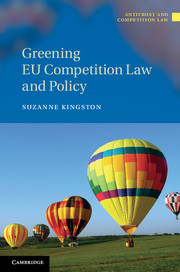Book contents
- Frontmatter
- Contents
- Foreword
- Acknowledgements
- Abbreviations
- Introduction
- Part I Should environmental goals play a role in EU competition law and policy?
- Part II The role of environmental protection in EU competition law and policy in practice
- 6 Some preliminary issues: definition of an undertaking; market definition; effect on inter-State trade
- 7 Article 101(1) TFEU
- 8 Article 101(3) TFEU
- 9 Article 102 TFEU
- 10 EU merger policy
- 11 The relevance of State action to Articles 101 and 102 TFEU
- 12 State aid
- Part III Conclusions
- Select bibliography
- Index
- References
10 - EU merger policy
from Part II - The role of environmental protection in EU competition law and policy in practice
Published online by Cambridge University Press: 05 November 2011
- Frontmatter
- Contents
- Foreword
- Acknowledgements
- Abbreviations
- Introduction
- Part I Should environmental goals play a role in EU competition law and policy?
- Part II The role of environmental protection in EU competition law and policy in practice
- 6 Some preliminary issues: definition of an undertaking; market definition; effect on inter-State trade
- 7 Article 101(1) TFEU
- 8 Article 101(3) TFEU
- 9 Article 102 TFEU
- 10 EU merger policy
- 11 The relevance of State action to Articles 101 and 102 TFEU
- 12 State aid
- Part III Conclusions
- Select bibliography
- Index
- References
Summary
Introduction: a role for environmental considerations in the EU's merger regime?
Prima facie, there is less scope for taking environmental considerations into account in applying the EU's merger regime than with other areas of EU competition law. This is essentially because, despite the transition in Regulation 139/2004 (the ‘Merger Regulation’) to the test of whether a concentration would significantly impede effective competition (the SIEC test), the Commission has been clear that, in practice, one of the primary forms of competitive harm in the case of concentrations remains the creation or strengthening of a dominant position (the dominance test). This means that, where a proposed concentration will create or strengthen a dominant position – a test that is based solely on whether economic power is significantly increased – the possibilities of nonetheless concluding that the SIEC test is not satisfied are few. Nonetheless, they are not non-existent, and in this sense the current Merger Regulation offers greater possibilities for integration than its 1989 predecessor, which relied solely on the dominance test. This chapter will examine the ways in which it might be argued that environmentally beneficial concentrations do not satisfy the SIEC test.
Overview
The Merger Regulation provides for a variety of factors to be taken into account in assessing whether a proposed concentration is compatible with the common market, i.e., whether the concentration would ‘significantly impede effective competition’. Some of these are set out in Article 2, headed ‘Appraisal of concentrations’, though this is not an exhaustive list.
- Type
- Chapter
- Information
- Greening EU Competition Law and Policy , pp. 328 - 342Publisher: Cambridge University PressPrint publication year: 2011

